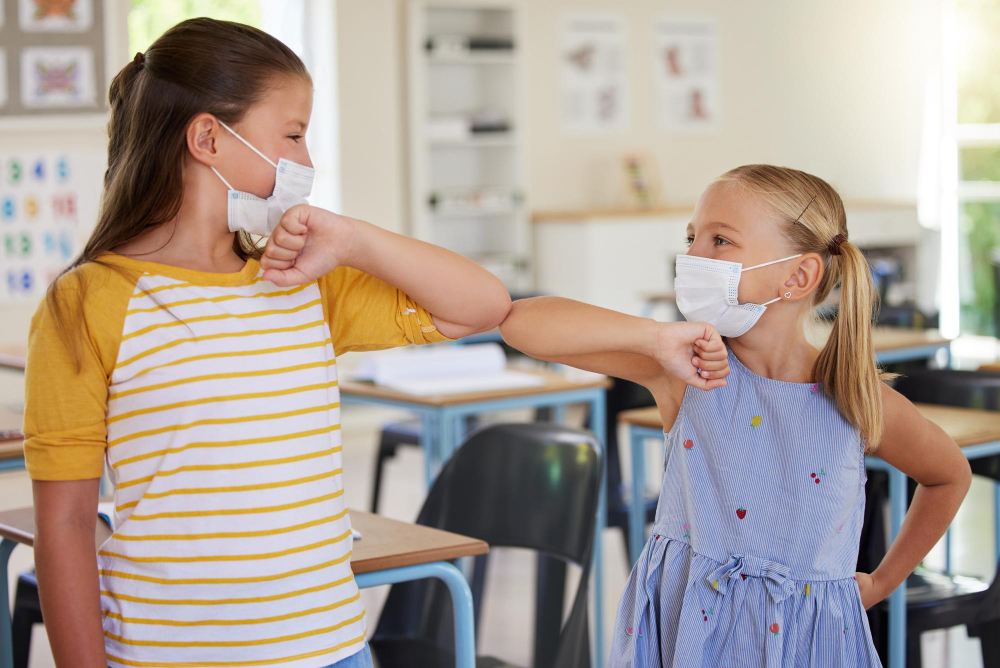Strep throat spreads quickly, especially in tight-knit communities like Naperville. The main culprit? A bacterium called Group A Streptococcus.
This type of bacteria lives in the nose and throat, making it easy to pass from person to person (transmit)—even before symptoms start showing. You don’t need to be in close contact for a prolonged period. Just a cough, a sneeze, or touching a contaminated surface can be enough to transfer the bacteria.
That’s why strep throat often runs through households, classrooms, or workplaces before anyone realizes what’s happening.
Spreading in Naperville Homes & Schools
In Naperville, families and students are at a higher risk of exposure during the colder months, when people spend more time indoors. Strep bacteria can live on surfaces like doorknobs, phones, and utensils.
When someone touches these items and then touches their mouth or nose, transmission can occur.
Transmission scenarios include:
- Sharing drinks or utensils
- Sneezing or coughing near others
- Touching your face after contact with contaminated surfaces
- Close contact in classrooms or playgroups
Young children are especially vulnerable, which is why strep throat often spreads in schools and daycare centers across Naperville.
Strep Throat in Naperville Schools and Classrooms
Schools and classrooms in Naperville are typical hotspots for strep throat outbreaks, especially during the fall and winter, when students spend hours together in close quarters—sharing supplies, using the same desks, and often forgetting to wash their hands.
Bacteria spread quickly and silently. One child with an undiagnosed case of strep can easily infect classmates before anyone realizes what’s happening.
Children are also more likely to touch their faces or share items like water bottles, snacks, or pencils, making it easier for Group A Streptococcus to pass from one student to another. Teachers and school staff may also be exposed, especially if sick children are not kept home.

How do schools become high-risk areas?
- Shared desks and classroom supplies make it easy for bacteria to pass from one child to another.
- Lunchrooms and playgrounds allow close face-to-face interactions where saliva droplets can be exchanged.
- Some children may be carriers of strep without showing symptoms, unknowingly spreading it to others.
Parents Should Stay Alert
Parents in Naperville play a vital role in identifying and preventing the spread of strep throat, especially among children who attend school, daycare, or participate in group activities.
Kids often struggle to describe their symptoms clearly, and early signs may be mistaken for a common cold or allergy. But strep throat can spread quickly, and children are often the first to bring it home to family members.
When parents stay alert to subtle changes—such as sudden fatigue, complaints of throat pain, or refusal to eat—it becomes easier to catch strep before it spreads through an entire class or household.
Warning signs parents should watch for:
- Sudden sore throat without coughing or sneezing
- Fever or chills paired with difficulty swallowing
- Child complains of headache, stomachache, or nausea (common in pediatric strep)
- Swollen glands or visible white patches in the throat
Prompt testing and care at a walk-in clinic like 1st ChoiceMed can help ensure your child recovers quickly—and prevent strep from spreading to others.
The Role of Surfaces in Spreading Strep
In Naperville’s homes, schools, and public spaces, one often-overlooked way that strep throat spreads is through contaminated surfaces.
The bacteria responsible for strep, Group A Streptococcus, can survive for hours on everyday objects—turning door handles, keyboards, phones, and countertops into silent spreaders.
People can unknowingly pick up the bacteria when they touch a contaminated surface and then rub their eyes, nose, or mouth. In shared environments such as classrooms, waiting rooms, or fitness centers, this form of indirect contact plays a significant role in transmission—especially when no one realizes that someone nearby is infected.
Common Surfaces to Watch:
- Shopping cart handles
- Touchscreens at checkout
- Doorknobs in restrooms and offices
Regularly cleaning and avoiding face-touching after coming into contact with these items can help reduce your risk.
Public Transit and Community Spaces
Public transit and shared community areas in Naperville—like buses, libraries, gyms, and waiting rooms—are places where strep throat can spread without direct contact.
When an infected person coughs, sneezes, or even talks loudly, tiny droplets carrying Streptococcus bacteria can land on nearby surfaces or be inhaled by others. In colder seasons, when windows are closed and indoor spaces get crowded, the risk of transmission increases.
Gyms with shared equipment, clinics with full waiting rooms, and busy CTA buses all become common sites of exposure.
Precaution Tips for Public Settings
- Keep a safe distance from visibly sick individuals
- Sanitize your hands after using shared equipment or touching high-contact surfaces
- Avoid touching your face until your hands are clean
Community education about strep symptoms and spread can reduce citywide outbreaks.
Early Testing in Preventing Spread
When it comes to strep throat, early testing is one of the most effective ways to stop the infection from spreading—especially in a close-knit community like Naperville.
Many people delay seeking care, assuming it’s just a minor issue, such as a sore throat. But if it’s actually strep, you may be contagious even before symptoms fully develop.
Urgent care centers like 1st ChoiceMed in Naperville offer quick, accurate rapid strep tests that can confirm the infection in just a few minutes. Knowing your diagnosis helps you take the proper steps to rest, recover, and protect others in your home, school, or workplace.
Where to Get Tested?
- Walk-in urgent care clinics, like 1st ChoiceMed
- School health offices for children showing symptoms
- Telehealth options may also guide you to the next steps
If you or your child experiences symptoms, don’t wait to see if they worsen. Quick action limits exposure to others.
Lower Your Risk at Home and in Public
Preventing the spread of strep throat in Naperville starts with everyday habits that protect both you and those around you.
Since strep bacteria travel through airborne droplets and surface contact, a mix of hygiene and awareness can go a long way in keeping your family safe. At home, frequent hand washing, disinfecting shared surfaces, and avoiding shared utensils can significantly reduce your exposure risk.
If someone in the household is sick, create separate spaces for eating and sleeping when possible. In public, carry hand sanitizer, avoid touching your face, and cover your mouth when sneezing or coughing to prevent the spread of germs.
- Wash your hands frequently, especially before eating or after touching shared items.
- Avoid sharing personal items like water bottles, food, or makeup
- Cover your mouth with a tissue or elbow when you sneeze or cough
- Disinfect commonly used surfaces in your home, school, or workplace
Want more tips on how to flu-proof your environment? Explore our guide to flu prevention at home
Stay Home If You Think You Have Strep
Yes. If you’re experiencing symptoms such as a sudden sore throat, fever, or swollen lymph nodes, staying home is the best course of action. Not only will you recover faster, but you’ll also prevent the spread of bacteria to others in your community.
Visit an urgent care center in Naperville, such as 1st ChoiceMed, for fast testing and evaluation. You can also read about how long strep throat lasts to plan your time better away from work or school.
For Further Information:
How is strep throat transmitted
Banish the bug – flu prevention
Can mouthwash prevent strep throat?
Learn More from the CDC on Strep Transmission
Want a deeper look at how strep spreads and how you can protect yourself and your family?
CDC – Group A Strep Transmission
FAQs
What causes strep throat?
Strep throat is caused by Group A Streptococcus bacteria, not a virus.
How long does it take to show symptoms?
Symptoms usually appear 2 to 5 days after exposure.
Can you spread strep before symptoms show?
Yes. People can be contagious even before they feel sick.
Is coughing a common way to spread it?
Yes. Coughing and sneezing release bacteria into the air and onto surfaces.
Can adults catch strep from kids?
Absolutely. It’s highly contagious across all age groups.
What’s the most common way it spreads?
Sharing drinks, kissing, or close contact are the top transmission methods.
Is strep more common during certain seasons?
Yes, it typically spikes in late fall, winter, and early spring.
Do masks help prevent transmission?
In crowded settings, masks can help reduce the spread of germs, especially when someone is coughing.
Can you get strep from touching surfaces?
Yes, the bacteria can live on surfaces. Handwashing is key.
Should you isolate if diagnosed with strep?
Yes. Stay home until your provider clears you to return to school or work.

